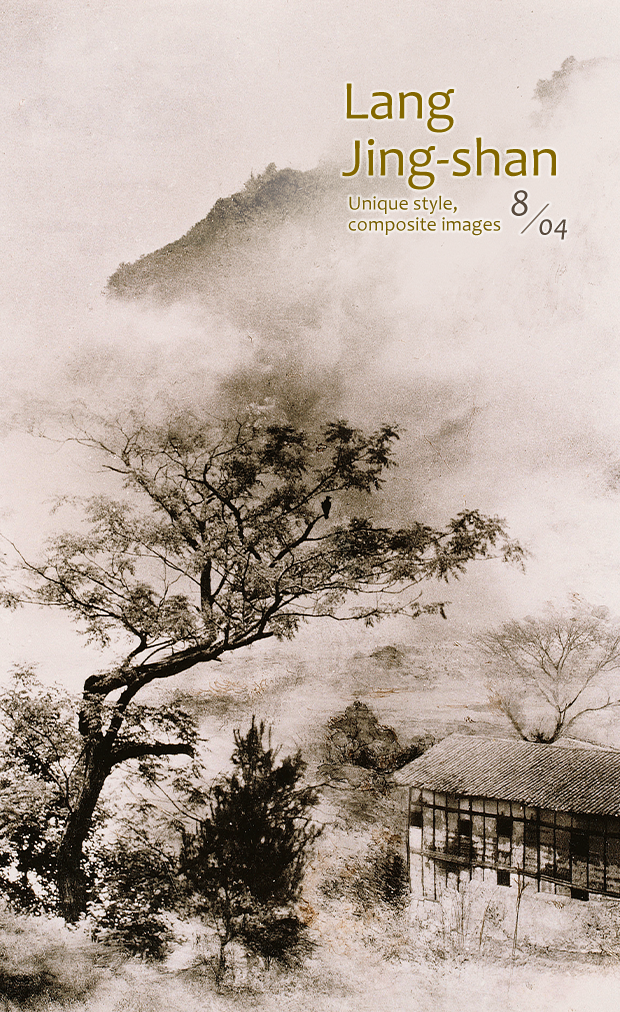

The renowned photographer Long Chin-san, or Lang Jing-shan, (1892-1995) was born as Lang Guodong in Huai'an City in China's Jiangsu Province, although his family hails from Hangzhou in Zhejiang Province. While attending the private Nanyang Junior High School in Shanghai, instructor Li Jinglan introduced Long to photographic principles, photo development and sun-printing techniques. In 1912, Long started working in the advertising department at the Shun Pao newspaper, where three years later he was promoted to director of advertising while also contributing advertising content to the Eastern Times in Shanghai. By this time, Long had already made a name for himself in Chinese photography circles. In 1919, he established the Ching Shan Advertising Agency and in 1928 helped launch Chung Hwa Photo (the Chinese Society of Photography). The following year saw his first book, The Photographic Works of Long Chin-san, published by China Fine Arts Publishing. In 1931, he started a photography course at Songjiang Girls' Junior High School in Shanghai, becoming a pioneer in photography education in China, while the Eastern Times held his first solo exhibition. Also in that year, his photograph Rowing was selected for the Fifth International Photographic Salon of Japan.
Long was a prominent force in the development of the Chinese photography scene, starting with the Chung Hwa Photo society and a joint exhibition in November 1932 with his friends Huang Zhongcheng and Liu Xucang. He later had a hand in forming a number of other societies, including the Chongqing and Kunming photographic societies in 1940 and the Shanghai Photographic Society and the Photographic Society of China in 1948, for which he served as director. That April he was invited by the government of Taiwan to hold an exhibition at Chungshan Hall in Taipei. Long in 1950 relocated from Hong Kong to Taiwan, where he three years later re-established the Photographic Society of China. After this, Long threw himself into his work as president of the society, while also introducing the International Salon of Photography to Taiwan and in 1966 establishing the Federation of Asian Photographic Art, which held an exchange exhibition every two years. In 1968 he started teaching photography at Chinese Culture University.
Long's early work was often published in periodicals such as the pictorial Liangyou (“The Young Companion”), Feiying and Tuhua Choukan. These pieces mostly consisted of bird-and-flower and still-life compositions, as well as landscapes and portraits, tending toward a more pictorial style. In the early 1930s as a reaction to negative depictions of China by foreigners, who focused on images of foot-binding or opium smoking, Long created spectacular images of Chinese landscapes using darkroom dodging and burning, even giving demonstrations of his retouching approach using ink-wash techniques during the Chinese art section of International Salon broadcasts. In 1934, one of his works using this technique, Spring Trees and Majestic Peaks, was selected for a photography exhibition in the UK. The foreword to the second collection of Long's work published in 1941 referred to this technique as “composite photography.” After meeting the Surrealist artist Man Ray in 1960, Long produced a series of photograms demonstrating the Chinese concept of line. Long is a recipient of the National Cultural Award, and in 1990 was awarded the First Class Professional Education-Culture Medal.(Content reviewed by Lang Yuwen)
The museum today holds 193 pieces by Long in its collection, including traditional and composite photographs, paper-based works, portraits and modern photography in genres ranging from landscapes to still lifes to portraits. With a collection reflective of the breadth of Long's creative style and his evolution as an artist, the museum is extremely proud to hold the most comprehensive and systematic collection of the celebrated photographer's work of any institution in the world. As part of its Artists' Day series that began in 2020, the museum has designated Long's birthday, August 4, as Long Chin-san Day. To celebrate, the public is invited to join in showing gratitude to this world-class master who used his photographic skill to create an ideal world.










